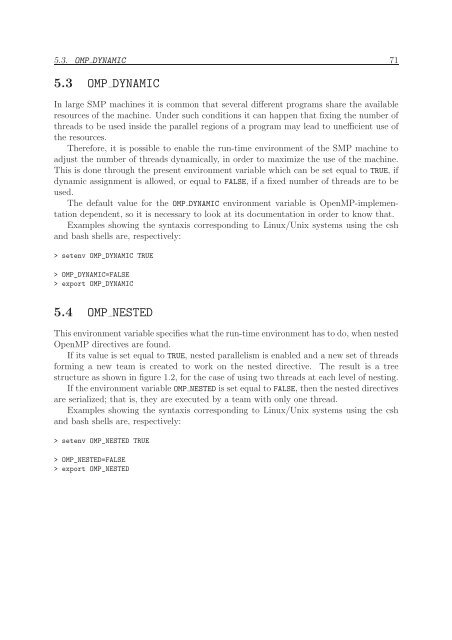Parallel Programming in Fortran 95 using OpenMP - People
Parallel Programming in Fortran 95 using OpenMP - People
Parallel Programming in Fortran 95 using OpenMP - People
You also want an ePaper? Increase the reach of your titles
YUMPU automatically turns print PDFs into web optimized ePapers that Google loves.
5.3. OMP DYNAMIC 71<br />
5.3 OMP DYNAMIC<br />
In large SMP mach<strong>in</strong>es it is common that several different programs share the available<br />
resources of the mach<strong>in</strong>e. Under such conditions it can happen that fix<strong>in</strong>g the number of<br />
threads to be used <strong>in</strong>side the parallel regions of a program may lead to unefficient use of<br />
the resources.<br />
Therefore, it is possible to enable the run-time environment of the SMP mach<strong>in</strong>e to<br />
adjust the number of threads dynamically, <strong>in</strong> order to maximize the use of the mach<strong>in</strong>e.<br />
This is done through the present environment variable which can be set equal to TRUE, if<br />
dynamic assignment is allowed, or equal to FALSE, if a fixed number of threads are to be<br />
used.<br />
The default value for the OMP DYNAMIC environment variable is <strong>OpenMP</strong>-implementation<br />
dependent, so it is necessary to look at its documentation <strong>in</strong> order to know that.<br />
Examples show<strong>in</strong>g the syntaxis correspond<strong>in</strong>g to L<strong>in</strong>ux/Unix systems us<strong>in</strong>g the csh<br />
and bash shells are, respectively:<br />
> setenv OMP_DYNAMIC TRUE<br />
> OMP_DYNAMIC=FALSE<br />
> export OMP_DYNAMIC<br />
5.4 OMP NESTED<br />
This environment variable specifies what the run-time environment has to do, when nested<br />
<strong>OpenMP</strong> directives are found.<br />
If its value is set equal to TRUE, nested parallelism is enabled and a new set of threads<br />
form<strong>in</strong>g a new team is created to work on the nested directive. The result is a tree<br />
structure as shown <strong>in</strong> figure 1.2, for the case of us<strong>in</strong>g two threads at each level of nest<strong>in</strong>g.<br />
If the environment variable OMP NESTED is set equal to FALSE, then the nested directives<br />
are serialized; that is, they are executed by a team with only one thread.<br />
Examples show<strong>in</strong>g the syntaxis correspond<strong>in</strong>g to L<strong>in</strong>ux/Unix systems us<strong>in</strong>g the csh<br />
and bash shells are, respectively:<br />
> setenv OMP_NESTED TRUE<br />
> OMP_NESTED=FALSE<br />
> export OMP_NESTED
















